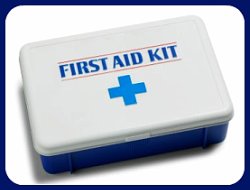Basic First Aid Kit
Checklist

A basic first aid kit doesn't need to include every piece of First Aid equipment although it might as well have basic yet useful content.
So what do we suggest goes in a basic first aid kit?
- Basic first aid manual - one that is easy to understand. Sometimes it's hard to remember what to do in an emergency. A pocket-sized manual comes in handy, taking you step-by-step through first aid care. We think it is best to read through it so the layout and contents are familiar before you need it in the heat of the moment.
- Antiseptic wipes or gel - for cleaning your hands before touching open cuts and wounds.
- Gauze and non-adhesive dressing pads - preferably sterile. They come in all sizes. One option, if you are trying to save space, is to get a bigger size dressing that you can cut to size as needed. It will save space.
- Elastic and crepe bandages - a few different widths.
- Triangular Bandage - For slings, padding, strapping limbs to splints when fractures are suspected.
- Adhesive Tape - I prefer paper tape as you do not have to have scissors to cut it as it will tear by just using your fingers - Get a good quality tape that will not get brittle with age or lose it's stickiness. It is useless when that occurs.
- Curved Scissors - Scissors come in handy in many ways. Curved medical ones are great as they don't have sharp points. In an emergency you might need to cut clothes away from an injury. With sharp edges it is easy to poke through something and cause further injury when you are in a hurry or under stress.
- Two tongue depressors or ice block sticks for finger splints.
- Instant Cold Pack/s - These are so useful for burns, bruising, swelling and sprains. They are single use, so if you have space grab a couple for your kit.
- Band Aids - a variety of shapes and sizes for small cuts and scrapes. I find the long strips of cloth tape with the padding in place already is great because you can cut it to size.
- Tweezers - A good pair of tweezers has easy-to-grip handles and can be used for splinter removal and other first aid procedures. Do not bother with a poor quality pair that will not grip a splinter you are trying to pull out as you will just get frustrated.
- Pain Reliever Capsules or liquid (liquid is best for children who can not swallow tablets).
- Anti-histamine - tablets or liquid (again for those that can not swallow tablets).
- Stings and Bites Cream- I prefer one with a local anaesthetic especially for the kids. My son scratches his bites when he is asleep and ends up with bleeding and weeping sores so knocking out the itchiness of bites before he goes to sleep reduces the scratching.
Other things to consider when putting together a basic first aid kit:
When an accident or injury occurs you may not have much time to read a manual while trying to give first aid to an injured person. We at FirstAidanywhere.com recommend you do a First Aid Training Course to learn what first aid challenges you may encounter and how to treat them.
The course you choose should include performing CPR, First Aid for Cuts and Scrapes, how to stop bleeding, how to stabilise a fractured limb, and how to treat burns, insect bites and other injuries.
You may also be interested in reading about:
First Aid for Cuts and Scrapes
Home
››
Basic First Aid Kit Checklist